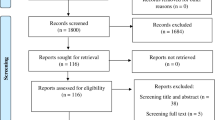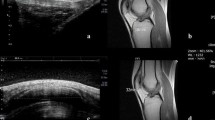Abstract
Introduction
Clinically measured Quadriceps angle (Q-angle) has low reliability. Measurement of angle between femoral shaft and patellar tendon (FSPT angle) on routine knee MRI was described in this study to represent the lateral vector forces of quadriceps mechanism. The cross-sectional study was designed to compare this angle between subjects with objective patellofemoral instability (PFI) versus those without PFI, to assess its reliability, and to assess its validity in terms of its ability to differentiate between PFI and non-PFI subjects using the “Receiver Operating Characteristic” (ROC) curve.
Materials and methods
MRI scans of 20 subjects with PFI and 20 without PFI were obtained. FSPT angle was measured in each MRI by three different raters. In addition, the clinical Q-angle was also measured in the control group.
Results
The FSPT angle was significantly higher in PFI group as compared with the non-PFI group (p < 0.001). It had substantial inter-rater reliability of 0.82 (95% CI = 0.67–0.92) in the non-PFI group and 0.89 (95% CI = 0.78–0.95) in the PFI group. Test-retest reliability was more than 0.90. The AUC for the ROC curve was 0.86 (95% CI = 0.74–0.97). The clinical Q-angle measured in non-PFI subjects had inter-rater reliability of only 0.48 (95% CI = 0.21–0.72), and showed a fair correlation of 0.58 with the MRI angle.
Conclusion
Measurement of FSPT angle was described on MRI with substantial intra-rater and inter-rater reliability. The angle was significantly higher in PFI versus non-PFI subjects and also showed a good ability to differentiate between these two groups in the ROC curve.




Similar content being viewed by others
Data availability
Data can be provided on request.
References
Brattström H. Shape of the intercondylar groove normally and in recurrent dislocation of patella: a clinical and X-ray anatomical investigation. Acta Orthop Scand. 1964;35:1–148. https://doi.org/10.3109/ort.1964.35.suppl-68.01.
Graf KH, Tompkins MA, Agel J, Arendt EA. Q-vector measurements: physical examination versus magnetic resonance imaging measurements and their relationship with tibial tubercle-trochlear groove distance. Knee Surg Sports Traumatol Arthrosc Off J ESSKA. 2018;26:697–704. https://doi.org/10.1007/s00167-017-4527-5.
Hungerford DS, Barry M. Biomechanics of the patellofemoral joint. Clin Orthop. 1979;144:9–15.
Freedman BR, Brindle TJ, Sheehan FT. Re-evaluating the functional implications of the Q-angle and its relationship to in-vivo patellofemoral kinematics. Clin Biomech Bristol Avon. 2014;29:1139–45. https://doi.org/10.1016/j.clinbiomech.2014.09.012.
Lan T-Y, Lin W-P, Jiang C-C, Chiang H. Immediate effect and predictors of effectiveness of taping for patellofemoral pain syndrome: a prospective cohort study. Am J Sports Med. 2010;38:1626–30. https://doi.org/10.1177/0363546510364840.
Sheehan FT, Derasari A, Fine KM, et al. Q-angle and J-sign: indicative of maltracking subgroups in patellofemoral pain. Clin Orthop. 2010;468:266–75. https://doi.org/10.1007/s11999-009-0880-0.
Felli L, Lovisolo S, Capello AG, et al. Arthroscopic lateral retinacular release and modified Goldthwait technique for patellar instability. Arthrosc Tech. 2019;8:e1295–9. https://doi.org/10.1016/j.eats.2019.07.001.
Greene CC, Edwards TB, Wade MR, Carson EW. Reliability of the quadriceps angle measurement. Am J Knee Surg. 2001;14:97–103.
Smith TO, Hunt NJ, Donell ST. The reliability and validity of the Q-angle: a systematic review. Knee Surg Sports Traumatol Arthrosc Off J ESSKA. 2008;16:1068–79. https://doi.org/10.1007/s00167-008-0643-6.
Ortqvist M, Moström EB, Roos EM, et al. Reliability and reference values of two clinical measurements of dynamic and static knee position in healthy children. Knee Surg Sports Traumatol Arthrosc Off J ESSKA. 2011;19:2060–6. https://doi.org/10.1007/s00167-011-1542-9.
Tomsich DA, Nitz AJ, Threlkeld AJ, Shapiro R. Patellofemoral alignment: reliability. J Orthop Sports Phys Ther. 1996;23:200–8. https://doi.org/10.2519/jospt.1996.23.3.200.
Gupta H, Batta NS, Kataria H, et al. A comparison of the reliability of the patellar tendon-trochlear groove (PTTG) distance and the tibial tuberosity-trochlear groove (TTTG) distance measured on MRI. Malays Orthop J. 2020;14:34–41. https://doi.org/10.5704/MOJ.2003.006.
Hinckel BB, Gobbi RG, Filho ENK, et al. Are the osseous and tendinous-cartilaginous tibial tuberosity-trochlear groove distances the same on CT and MRI? Skelet Radiol. 2015;44:1085–93. https://doi.org/10.1007/s00256-015-2118-4.
Ando T, Hirose H, Inoue M, et al. A new method using computed tomographic scan to measure the rectus femoris-patellar tendon Q-angle comparison with conventional method. Clin Orthop. 1993;289:213–219.
Ando T. Factors affecting the rectus femoris-patellar tendon Q-angle, measured using a computed tomographic scan. J Orthop Sci Off J Jpn Orthop Assoc. 1999;4:73–7. https://doi.org/10.1007/s007760050077.
Pandit S, Frampton C, Stoddart J, Lynskey T. Magnetic resonance imaging assessment of tibial tuberosity-trochlear groove distance: normal values for males and females. Int Orthop. 2011;35:1799–803. https://doi.org/10.1007/s00264-011-1240-8.
Schoettle PB, Zanetti M, Seifert B, et al. The tibial tuberosity-trochlear groove distance; a comparative study between CT and MRI scanning. Knee. 2006;13:26–31. https://doi.org/10.1016/j.knee.2005.06.003.
Sanfridsson J, Arnbjörnsson A, Fridén T, et al. Femorotibial rotation and the Q-angle related to the dislocating patella. Acta Radiol Stockh Swed. 2001;42:218–24.
Wu C-C. Is clinical measurement of anatomic axis of the femur adequate? Acta Orthop. 2017;88:407–10. https://doi.org/10.1080/17453674.2017.1304788.
Brady JM, Rosencrans AS, Shubin Stein BE. Use of TT-PCL versus TT-TG. Curr Rev Musculoskelet Med. 2018;11:261–5. https://doi.org/10.1007/s12178-018-9481-4.
Guerra JP, Arnold MJ, Gajdosik RL. Q angle: effects of isometric quadriceps contraction and body position. J Orthop Sports Phys Ther. 1994;19:200–4. https://doi.org/10.2519/jospt.1994.19.4.200.
Grelsamer RP, Newton PM, Staron RB. The medial-lateral position of the patella on routine magnetic resonance imaging: when is normal not normal? Arthrosc J Arthrosc Relat Surg Off Publ Arthrosc Assoc N Am Int Arthrosc Assoc. 1998;14:23–8. https://doi.org/10.1016/s0749-8063(98)70116-1.
Freedman BR, Sheehan FT. Predicting three-dimensional patellofemoral kinematics from static imaging-based alignment measures. J Orthop Res Off Publ Orthop Res Soc. 2013;31:441–7. https://doi.org/10.1002/jor.22246.
Insall J, Falvo KA, Wise DW. Chondromalacia Patellae. A prospective study J Bone Joint Surg Am. 1976;58:1–8.
Piva SR, Fitzgerald K, Irrgang JJ, et al. Reliability of measures of impairments associated with patellofemoral pain syndrome. BMC Musculoskelet Disord. 2006;7:33. https://doi.org/10.1186/1471-2474-7-33.
Horton MG, Hall TL. Quadriceps femoris muscle angle: normal values and relationships with gender and selected skeletal measures. Phys Ther. 1989;69:897–901. https://doi.org/10.1093/ptj/69.11.897.
Shrout PE. Measurement reliability and agreement in psychiatry. Stat Methods Med Res. 1998;7:301–17. https://doi.org/10.1177/096228029800700306.
Fox J (2005) The R commander: a basic-statistics graphical user interface to R. J Stat Softw 14:1–42. https://doi.org/10.18637/jss.v014.i09.
R Core Team (2018) R: A language and environment for statistical computing, Reference Index, Version 4.0.0. R Foundation for Statistical Computing, Vienna.
Biedert RM, Warnke K. Correlation between the Q angle and the patella position: a clinical and axial computed tomography evaluation. Arch Orthop Trauma Surg. 2001;121:346–9. https://doi.org/10.1007/s004020000239.
Cooney AD, Kazi Z, Caplan N, et al. The relationship between quadriceps angle and tibial tuberosity-trochlear groove distance in patients with patellar instability. Knee Surg Sports Traumatol Arthrosc Off J ESSKA. 2012;20:2399–404. https://doi.org/10.1007/s00167-012-1907-8.
Amis AA. Current concepts on anatomy and biomechanics of patellar stability. Sports Med Arthrosc Rev. 2007;15:48–56. https://doi.org/10.1097/JSA.0b013e318053eb74.
Harbaugh CM, Wilson NA, Sheehan FT. Correlating femoral shape with patellar kinematics in patients with patellofemoral pain. J Orthop Res Off Publ Orthop Res Soc. 2010;28:865–72. https://doi.org/10.1002/jor.21101.
Roach KE. Measurement of health outcomes: reliability, validity and responsiveness. JPO J Prosthet Orthot. 2006;18:P8.
Reider B, Marshall JL, Warren RF. Clinical characteristics of patellar disorders in young athletes. Am J Sports Med. 1981;9:270–4. https://doi.org/10.1177/036354658100900419.
Livingston LA. The quadriceps angle: a review of the literature. J Orthop Sports Phys Ther. 1998;28:105–9. https://doi.org/10.2519/jospt.1998.28.2.105.
Caylor D, Fites R, Worrell TW. The relationship between quadriceps angle and anterior knee pain syndrome. J Orthop Sports Phys Ther. 1993;17:11–6. https://doi.org/10.2519/jospt.1993.17.1.11.
Draper CE, Chew KTL, Wang R, et al. Comparison of quadriceps angle measurements using short-arm and long-arm goniometers: correlation with MRI. PM R. 2011;3:111–6. https://doi.org/10.1016/j.pmrj.2010.10.020.
Author information
Authors and Affiliations
Corresponding author
Ethics declarations
Conflicts of interest
The authors declare that they have no conflict of interest.
Ethics approval
Prior ethical approval was obtained from the Institutional Ethics Committee.
Consent to participate
Consent was taken from all subjects enrolled from out-patient department. Not required for archival data.
Consent for publication
The manuscript does not include photographs of patients or patient identification.
Code availability
NA
Additional information
Publisher’s note
Springer Nature remains neutral with regard to jurisdictional claims in published maps and institutional affiliations.
Rights and permissions
About this article
Cite this article
Gupta, H., Kataria, H., Batta, N.S. et al. Assessment of validity and reliability of femoral shaft-patellar tendon angle measured on MRI. Skeletal Radiol 50, 927–936 (2021). https://doi.org/10.1007/s00256-020-03636-0
Received:
Revised:
Accepted:
Published:
Issue Date:
DOI: https://doi.org/10.1007/s00256-020-03636-0




